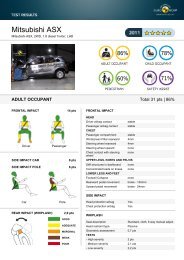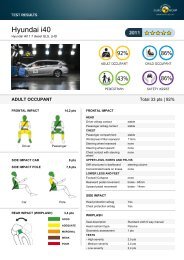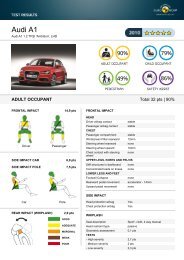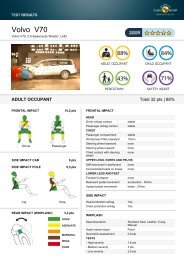Pedestrian Test Protocol - Euro NCAP
Pedestrian Test Protocol - Euro NCAP
Pedestrian Test Protocol - Euro NCAP
Create successful ePaper yourself
Turn your PDF publications into a flip-book with our unique Google optimized e-Paper software.
8.5.2 Static pedestrian tests<br />
8.5.2.1 Static pedestrian tests will be performed in the normal way and according to the<br />
usual tolerances.<br />
8.5.3 Dynamic pedestrian tests<br />
8.5.3.1 Where dynamic tests are required, only a lateral impact tolerance of +/-10mm will be<br />
required. The headform shall be aimed at the grid point, the subsequent impact<br />
location on the bonnet top will then be determined by the timing of the bonnet<br />
deployment relative to the propulsion of the headform.<br />
8.5.3.2 The vehicle manufacturer will be required to provide <strong>Euro</strong> <strong>NCAP</strong> with data from<br />
numerical simulations performed with the bonnet in the undeployed position.<br />
Simulations are to be conducted with a vehicle speed of 40km/h with all pedestrian<br />
statures that result in head contact to bonnet. <strong>Pedestrian</strong> models should be selected<br />
from the following statures, a 6 year old, 5th percentile female, 50th percentile male<br />
and 95th percentile male. The pedestrian position and stance to be used in the model<br />
is defined in Section 2.6.1.5.<br />
8.5.3.3 From the simulations both head contact time and the wrap around distance that the<br />
head contacts the bonnet should be recorded.<br />
8.5.3.4 A graph shall be plotted with a best fit straight line as shown in Figure 22. When a<br />
test point is selected, as the wrap distance will be known, the equivalent head contact<br />
time can be obtained from the graph that will be used in the dynamic test set up.<br />
Version 7.0<br />
March 2013<br />
Head Contact Time (ms)<br />
138<br />
128<br />
118<br />
108<br />
98<br />
88<br />
78<br />
68<br />
58<br />
6yr Old<br />
5%tile<br />
1000 1100 1200 1300 1400 1500 1600 1700 1800 1900<br />
WRAP Distance (mm)<br />
Figure 22: WAD vs HIT<br />
50%tile<br />
8.5.3.5 The vehicle manufacturer must provide the test laboratory with all the necessary<br />
details of how to trigger the system, monitor trigger signals and replace spare parts.<br />
8.5.4 Upper leg test zones<br />
8.5.4.1 The test sites will be chosen with the bonnet in its un-deployed state. If bonnet<br />
deployment occurs prior to pedestrian contact with the Bonnet Leading Edge,<br />
creating an increased hazard such as higher BLE height and/or bumper lead, the<br />
<strong>Euro</strong> <strong>NCAP</strong> secretariat will give consideration to marking out the BLE in the<br />
deployed state.<br />
8.5.4.2 Unless there is concern about additional hazards being created by the bonnet<br />
deploying prior or during pedestrian contact with the Bonnet Leading Edge, all<br />
upper legform to bonnet leading edge testing will be carried out with the bonnet in<br />
33
















